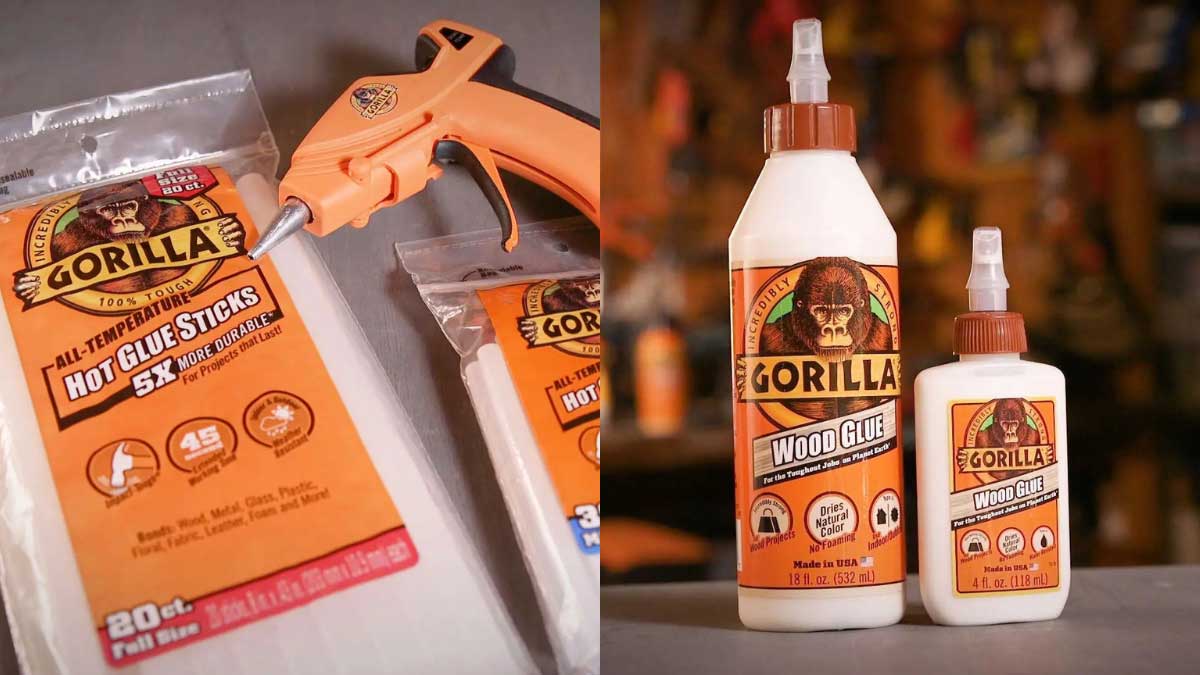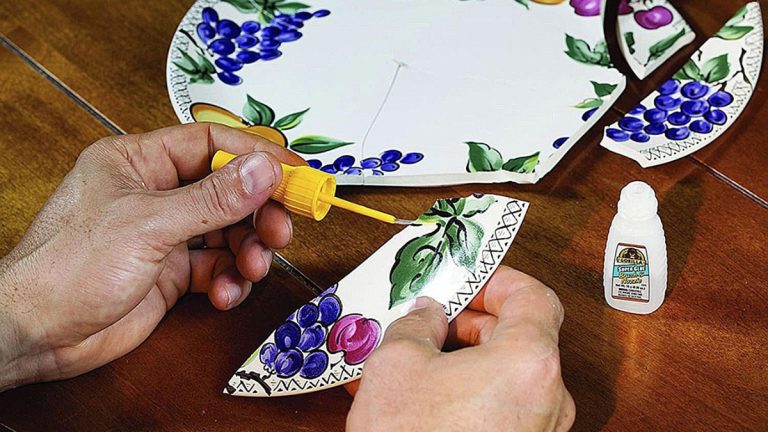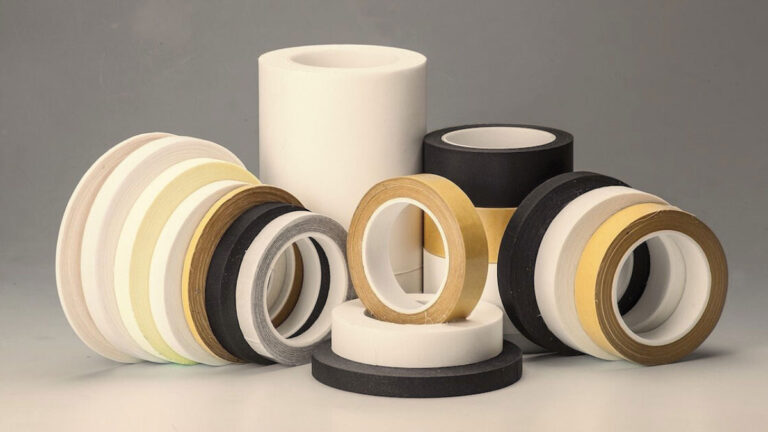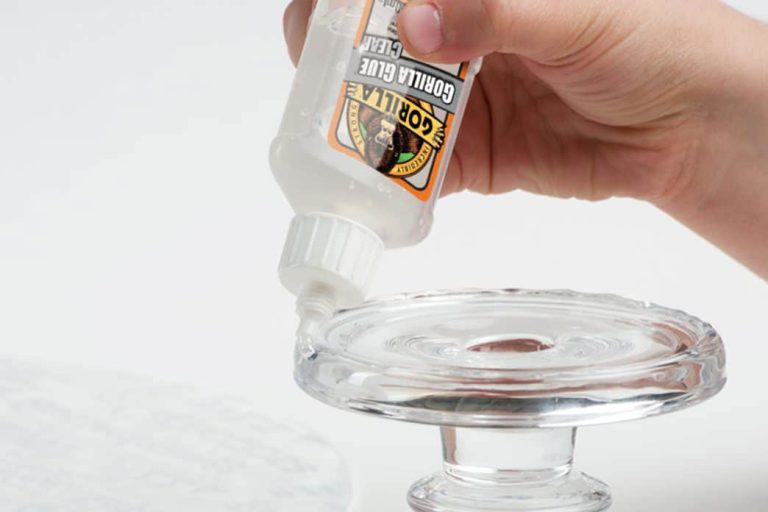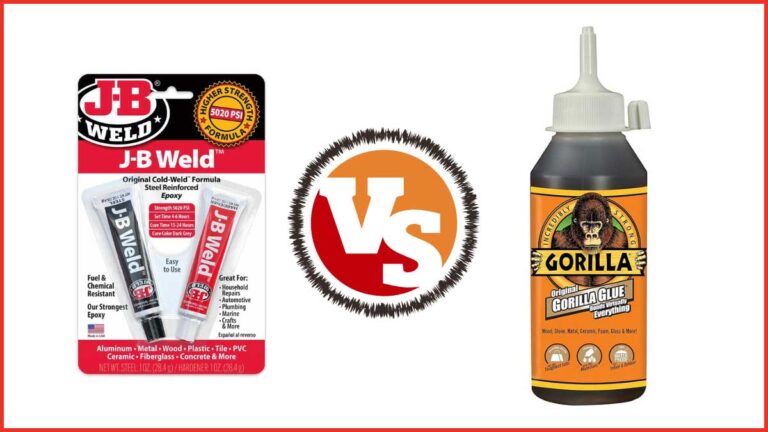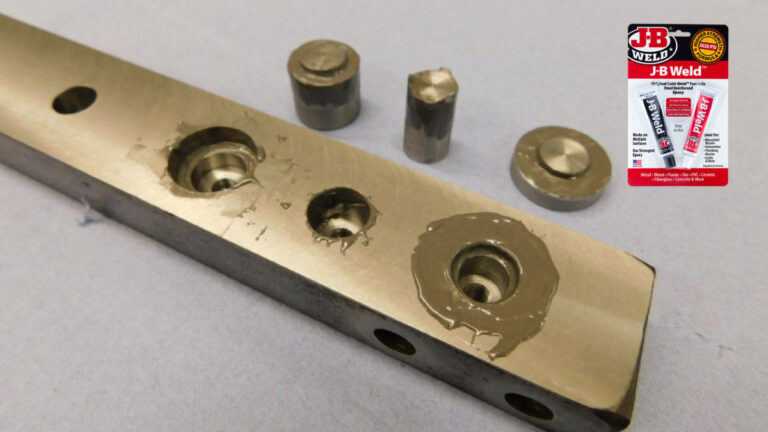Hot Glue vs Wood Glue: Choosing the Right Adhesive for Projects
Choosing the right adhesive can make or break your woodworking project. Whether you’re a DIY enthusiast or a seasoned carpenter, understanding the differences between hot glue and wood glue is crucial. Each type of glue has its own set of strengths and weaknesses, making them suitable for different tasks.
Hot glue offers quick bonding and versatility, ideal for temporary fixes and crafts. On the other hand, wood glue provides a strong, durable bond specifically designed for wood-to-wood connections. Knowing when to use each can save you time and ensure your projects hold up under pressure. Let’s jump into the key differences to help you make an well-informed choice.
Key Takeaways
- Hot Glue vs. Wood Glue: Understand the distinct characteristics and applications of hot glue and wood glue to choose the right adhesive for your project.
- Hot Glue Benefits: Quick bonding and versatile, suitable for temporary fixes, crafts, filling gaps, and bonding various materials like wood, fabric, and plastics.
- Wood Glue Strength: Provides a strong, durable bond designed specifically for wood, ideal for structural joints and high-stress applications.
- Application Time: Hot glue sets rapidly, while wood glue requires clamping and longer drying times to ensure maximal strength.
- Environmental Resistance: Hot glue has limited resistance to extreme heat and moisture, whereas specific types of wood glue offer high resistance, making them suitable for outdoor use.
- Project Suitability: Choose hot glue for quick, versatile projects needing immediate adhesion; opt for wood glue for durable, long-lasting wood bonds, especially in load-bearing tasks.
Overview of Hot Glue and Wood Glue
When choosing between hot glue and wood glue for your projects, it’s crucial to understand the distinct characteristics of each adhesive. Both types of glue serve specific functions and knowing when to use them can save time and improve the durability of your work.
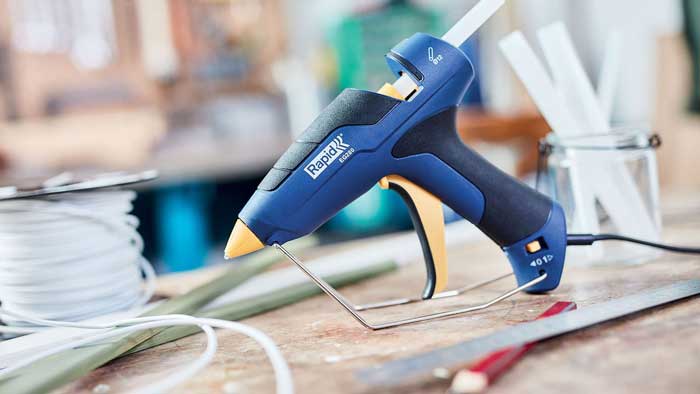
What is Hot Glue?
Hot glue, also known as hot melt adhesive, is applied using a hot glue gun. Here are its key characteristics:
- Application: You use a hot glue gun to heat the adhesive, which melts and bonds materials upon cooling.
- Versatility: Hot glue bonds a wide range of materials such as wood, fabric, paper, plastics, ceramics, and certain metals.
- Bonding Time: It sets rapidly, offering immediate adhesion ideal for quick projects.
- Strength: While not ideal for high-strength applications, it can achieve significant strength if applied correctly.
- Temperature Range: Hot glue retains adhesive properties across various temperatures but may fail under extreme heat.
What is Wood Glue?
Wood glue, specifically designed for bonding wood, is a staple in woodworking. Here are its primary attributes:
- Types: Common types include PVA (polyvinyl acetate) glue, hide glue, and epoxy.
- Application: Typically applied in a thin layer between wood surfaces and requires clamping to ensure a strong bond.
- Drying Time: Generally takes longer to set compared to hot glue, often needing several hours to fully cure.
- Strength: Provides a durable, long-lasting bond stronger than the wood itself; suitable for high-stress applications.
- Moisture Resistance: Varieties like Type I and Type II wood glues offer varying levels of water resistance.
| Feature | Hot Glue | Wood Glue |
|---|---|---|
| Application | Hot glue gun | Direct application, needs clamping |
| Versatility | Bonds various materials | Specifically for wood |
| Bonding Time | Sets rapidly | Takes several hours |
| Strength | Moderate, not for high-stress | High-strength, surpasses wood’s strength |
| Temperature | Performs across wide range | Requires stable environmental conditions |
| Moisture Resist. | Limited | Types with different moisture resistance |
Understanding the differences between hot glue and wood glue helps you choose the right adhesive for your project, whether it demands the quick setting of hot glue or the robust strength of wood glue. By leveraging their unique properties, you can achieve optimal results in your woodworking endeavors.
Applications and Uses
When tackling various DIY projects and crafts, choosing the right adhesive can significantly influence the outcome. Understanding the applications and uses of hot glue vs wood glue can save you time and ensure your projects are durable and effective.
Common Uses for Hot Glue
- Quick Bonding and Crafts
- Hot glue is ideal for projects requiring rapid adhesion. It dries quickly, making it perfect for arts and crafts, DIY repairs, and other applications needing immediate bonding.
- It’s versatile and bonds with wood, fabric, paper, plastics, ceramics, and certain metals. For example, you can use hot glue to quickly assemble a paper craft or repair a ceramic ornament.
- Filling Gaps and Uneven Surfaces
- Due to its high viscosity, hot glue excels at filling gaps and bonding uneven surfaces. This makes it useful for projects where surfaces aren’t perfectly smooth.
- If you’re working on a decorative piece with intricate designs, hot glue can bridge small gaps effectively.
- Temporary or Low-Stress Bonds
- Hot glue isn’t typically used in high-strength applications. It’s better suited for projects not needing to withstand significant stress or weight.
- You can easily break the bond with minimal force, making it convenient for temporary bonds. For instance, hot glue is great for creating temporary fixtures during a larger project.
Common Uses for Wood Glue
- Strong, Durable Bonds for Woodworking
- Wood glue creates an exceptionally strong bond specifically designed for wood. It’s often stronger than the wood itself.
- If you’re assembling a wooden chair or table, wood glue ensures a long-lasting and sturdy bond.
- Clamping Required for Efficient Bonding
- Most wood glues require clamping until the adhesive sets, ensuring maximum strength.
- For detailed woodworking projects like building a bookshelf, clamping ensures each joint is secure and durable.
- Resistant to Environmental Conditions
- Wood glue offers high resistance to moisture and temperature variations, making it suitable for both indoor and outdoor projects.
- Building a wooden fence or outdoor furniture means opting for wood glue to withstand varying weather conditions.
| Feature | Hot Glue | Wood Glue |
|---|---|---|
| Bonding Speed | Dries quickly | Takes longer (requires clamping) |
| Versatility | Bonds various materials | Designed specifically for wood |
| Strength | Suitable for low-stress bonds | Provides highly durable bonds |
| Filling Gaps | Excellent due to high viscosity | Not ideal for filling large gaps |
| Environmental Resistance | Limited resistance to moisture and temperature | High resistance to moisture and temperature |
Understanding the strengths and limitations of hot glue vs wood glue helps tailor your adhesive choices to specific project requirements. Whether for quick crafts or long-lasting wood furniture, selecting the right glue ensures professional and durable results.
Strength and Durability
Understanding the strength and durability of hot glue versus wood glue helps you choose the right adhesive for your project. Here’s a look at how these glues compare in terms of bonding capability and resilience.
Hot Glue Bonding Strength
Hot glue provides quick bonding and versatility. It forms a strong bond with diverse materials:
- Wood: Adequate for temporary fixes or crafts but not for load-bearing joints.
- Fabric: Bonds quickly without damaging delicate materials.
- Paper: Ideal for lightweight paper projects requiring immediate adhesion.
- Plastics: Effective for non-structural bonds with plastics like polystyrene.
- Ceramics: Works for lightweight or decorative ceramic repairs.
- Metals: Limited use, generally suitable for low-stress applications.
Shear Strength: This metric measures how well the adhesive holds under pressure from sliding forces. Hot glue’s shear strength can reach over 1,000 pounds under optimal conditions, such as proper heating and quality glue types. This strength varies based on the glue’s formulation and the application method. Low-quality or incorrectly applied hot glue can be significantly weaker.
| Material | Typical Use | Bonding Speed | Optimal Condition |
|---|---|---|---|
| Wood | Temporary fixes, crafts | Immediate | Adequate heating both surfaces |
| Fabric | Crafts, fabric embellishments | Immediate | Proper heating, minimal fabric damage |
| Paper | Lightweight projects, scrapbooks | Immediate | Fast setting |
| Plastics | Non-structural, decorative | Immediate | Works with polystyrene |
| Ceramics | Lightweight repairs | Immediate | Limited to decorative repairs |
| Metals | Low-stress applications | Immediate | Effective in non-structural contexts |
Wood Glue Bonding Strength
Wood glue, designed specifically for wood, provides excellent bonding strength and durability:
- Clamping Requirement: Enhances bond strength by holding pieces tightly together until the adhesive cures fully.
- Longer Drying Time: Typically requires several hours to a full day, depending on the type and humidity.
- Water-Resistant: Available formulations (e.g., Titebond III) offer water resistance, essential for outdoor projects.
- Strong Bond: Often stronger than the wood itself, making it ideal for structural joints and load-bearing applications.
Tensile Strength: This metric measures the glue’s ability to withstand tension or pulling forces. Wood glue typically showcases high tensile strength, ensuring durability and longevity of joints.
| Glue Type | Drying Time | Clamping Time | Water-Resistance | Typical Application |
|---|---|---|---|---|
| PVA | 30 minutes – 24 hrs | 30 minutes – 12 hrs | Moderate (Type II: Excellent) | Furniture, cabinetry, indoor usage |
| Polyurethane | 4-6 hours | 2-4 hours | High (Type I: Submersion) | Outdoor furniture, projects exposed to moisture |
| Epoxy | 6-30 minutes | Minimal clamp time | Very high | Marine and structural applications |
Summary
Both hot glue and wood glue have distinct advantages. Choose hot glue for projects needing quick, versatile bonds with various materials. For strong, durable wood joints, use wood glue, especially for load-bearing tasks requiring water resistance. Evaluate the project’s requirements to select the optimal adhesive.
Pros and Cons
Choosing between hot glue and wood glue is pivotal for the success and durability of your project. Each adhesive offers unique advantages and disadvantages. Here’s a closer look at both:
Advantages and Disadvantages of Hot Glue
Advantages:
- Quick Bonding: Hot glue bonds instantly, eliminating the need for extended drying times. This is perfect for projects needing immediate adhesion, such as crafting or temporary fixes.
- Versatility: This adhesive works well with various materials, including wood, fabric, paper, plastics, ceramics, and certain metals.
- Wide Temperature Range: Hot glue maintains its adhesive properties under varying conditions and performs reliably across a broad temperature spectrum.
- Flexibility and Shock Absorption: The glue allows slight movements and expansions in the bonded materials without compromising the bond, making it ideal for applications requiring resilience and impact resistance.
- Easy Application and Cleanup: Simple to apply with good control, hot glue also provides convenient cleanup when still in its molten state.
Disadvantages:
- Limited Strength: Hot glue isn’t suitable for high-strength applications. It provides less durable bonds compared to wood glue, particularly in load-bearing tasks.
- Heat Sensitivity: Bonds may weaken under high temperatures, limiting its use in heat-prone environments.
- Surface Preparation: Proper surface preparation is crucial, as hot glue may not bond well on dirty or greasy surfaces.
Advantages and Disadvantages of Wood Glue
Advantages:
- Strong Bonds: Wood glue offers robust bonding, often stronger than the wood itself. It’s specifically designed for wood connections, making it ideal for woodworking projects.
- Durability: It provides a durable bond suitable for long-term use, ensuring the stability and longevity of your wooden structures.
- Water Resistance: Available in water-resistant formulations, wood glue can withstand environmental conditions, making it ideal for outdoor projects.
- Variety: Different types include PVA glue, aliphatic resin, and polyurethane glue, each offering unique properties tailored to specific tasks.
- Longer Drying Time: Wood glue requires clamping and extended drying times due to its nature, which slows down the project completion.
- Material Limitation: It’s primarily designed for wood and may not bond effectively with other materials.
- Cleanup: Cleaning up wood glue can be challenging, especially once it has dried. Immediate cleanup is essential.
| Aspect | Hot Glue | Wood Glue |
|---|---|---|
| Bonding Time | Instant bonding | Requires clamping and time to dry |
| Versatility | Bonds a wide range of materials | Primarily for wood |
| Temperature Range | Wide range, less effective at high temperatures | Stable under varying conditions |
| Strength | Less strong, not for load-bearing applications | Strong, durable bonds |
| Flexibility | Allows slight movement and expansion | Rigid once dried |
| Cleanup | Easy when molten | Difficult once dried |
| Water Resistance | Limited | Available in water-resistant forms |
| Applications | Crafts, temporary fixes, non-load-bearing tasks | Woodworking, long-term wood bonds |
Understand your project’s needs to determine the optimal adhesive. Hot glue excels in quick, versatile applications for various materials, while wood glue provides strong, durable bonds for wood, especially in load-bearing tasks requiring resilience to environmental conditions.
Choosing the Right Glue for Your Project
Selecting the right adhesive can be crucial for the success of your project. The choice between hot glue and wood glue depends on various factors like material type, required strength, and application process.
Factors to Consider
Bond Strength and Durability:
- Wood Glue: Provides a robust and lasting bond, optimal for wood-to-wood joints. For instance, Titebond offers a durable connection that can endure for decades, suitable for high-strength needs.
- Hot Glue: Though versatile, hot glue usually doesn’t measure up to wood glue in terms of durability. It can hold well under optimal conditions but isn’t ideal for applications needing sustained strength.
Application Time and Ease:
- Wood Glue: Requires a longer setting time, beneficial for complex assemblies needing precise alignment. Easily spreadable for full joint coverage; excess can be wiped with a damp rag.
- Hot Glue: Cures rapidly, making it suitable for quick fixes or projects demanding immediate bonding. Requires the use of a hot glue gun, which adds convenience but also necessitates caution due to the high temperature.
Specific Project Examples
Craft Projects:
- Hot Glue: Ideal for quick and flexible bonding in arts and crafts. It works well with materials like fabric, paper, and light wood. For example, assembling a cardboard model can be efficiently handled with hot glue due to its rapid curing time.
Furniture Assembly:
- Wood Glue: Essential for constructing furniture, offering a strong and permanent bond. When building a wooden chair, use wood glue to ensure joints remain intact under stress, providing long-term stability.
Repair Jobs:
- Hot Glue: Suitable for repairing everyday items like plastic toys or minor household fixtures. Its versatility allows it to bond a range of materials quickly.
- Wood Glue: Best for repairing wooden furniture or objects, providing a sturdier and more resilient fix.
Outdoor Projects:
- Wood Glue: Choose wood glue formulated with water resistance for exterior woodwork like birdhouses or garden furniture. It’s designed to withstand environmental conditions, ensuring longevity.
| Factor | Wood Glue | Hot Glue |
|---|---|---|
| Material Compatibility | Best for wood | Versatile (wood, fabric, plastic) |
| Bond Strength | High, often stronger than wood itself | Moderate, varies by material |
| Durability | Long-term stability, can last for decades | Less durable over time |
| Application Time | Longer setting and curing time | Quick, sets within minutes |
| Ease of Use | Requires precise spreading and clamping | Easy application with hot glue gun |
| Cleanup | Damp rag can remove excess when wet, difficult when dry | Easy while hot, challenging once set |
| Water Resistance | Available in formulations for outdoor use | Generally not water-resistant |
Choosing the appropriate glue ensures the success and durability of your project. For intricate woodworking or load-bearing tasks, wood glue emerges as the clear choice. Conversely, for diverse, quick-fix, or art-related projects, hot glue offers unmatched convenience and versatility.
Conclusion
Choosing the right adhesive is essential for the success and durability of your projects. Hot glue offers unmatched convenience for quick fixes and craft projects, providing versatility and ease of use. For intricate woodworking or load-bearing tasks, wood glue stands out with its superior bonding strength and long-term stability. By understanding the strengths and limitations of each adhesive, you can ensure your projects are both time-efficient and durable. Make informed decisions based on your specific needs to achieve the best results.
Frequently Asked Questions
Does hot glue come off wood easily?
Yes, hot glue can be removed from wood by pouring rubbing alcohol around the edges of the glue. This helps the glue to soak in and peel off easily.
How permanent is hot glue?
Hot glue provides a relatively strong bond for a variety of materials like paper, cardboard, fabric, and certain plastics and metals. For these applications, the bond can often be considered permanent.
Can I use hot glue instead of wood glue?
Hot glue can be used for woodworking projects that don’t need to bear high stress. It is versatile and works well on various types of wood, including painted or stained wood. However, it may not be suitable for heavy-duty, load-bearing tasks.
What is the strongest hot glue for wood?
Polyurethane PUR hot melt adhesive is considered one of the strongest hot glue options for woodworking. It dispenses from a PUR glue gun and continues to strengthen as it reacts with moisture in the air.
What works better than wood glue?
For heavy-duty construction work, construction adhesives are more effective than wood glue. They are capable of filling small and large gaps and maintain flexibility, making them suitable for joining concrete or other strong materials.
Which glue is better for furniture assembly, hot glue or wood glue?
Wood glue is better for furniture assembly due to its strong, durable bond. It requires clamping and a longer drying time but offers a more stable and long-lasting connection ideal for load-bearing tasks.
What are the limitations of using hot glue for woodworking?
Hot glue has limitations such as lower strength compared to wood glue, heat sensitivity, and the need for proper surface preparation. It is best suited for quick fixes and non-load-bearing applications rather than for structural woodworking.
Can hot glue withstand outdoor conditions?
Hot glue generally does not perform well under outdoor conditions due to its sensitivity to temperature changes. For outdoor use, wood glue with water-resistant formulations is recommended for longevity and durability.

